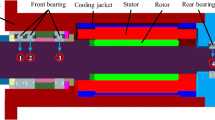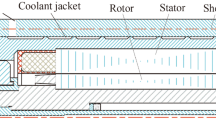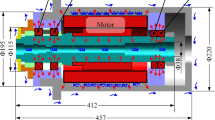Abstract
The motorized spindle will produce a lot of heat at high speed, thereby making the physical structures deformed and changing the bearing performances. However, the interaction between thermal and mechanical characteristics has not been deeply studied. This paper aimed to consider the coupling of interference fit, centrifugal effect, and thermal effect in these components to build a comprehensive and optimized spindle model. Firstly, the displacements related to contact angles under the thermo-mechanical coupling effect were analyzed, and the oil film factor was added to the bearing static model to be studied together with centrifugal force and gyroscopic moment of the ball. Next, based on thermal network method, a quasi-3D model of cooling water pipe was established by considering its structural characteristics. Meanwhile, for the discussion of the number of balls and their thermal resistances, the heat transfer between the bearing ring and the ball was investigated and improved. Lastly, the influences of thermal characteristics on bearings parameters and spindle temperature rise were investigated under different speed, cooling water, and oil-air variables, which provide a reference for regulating and controlling motorized spindle.


























Similar content being viewed by others
Availability of data and materials
The data used or analyzed in this paper is not available as it pertains to an ongoing research.
References
Uhlmann E, Hu J (2012) Thermal modelling of a high speed motor spindle. Procedia CIRP 1(1):313–318
Li B, Cao H, Yang X, Jafar S, Zeng D (2018) Thermal energy balance control model of motorized spindle system enabling high-speed dry hobbing process. J Manuf Process 35(10):29–39
Bossmanns B, Tu JF (2001) A power flow model for high speed motorized spindles—heat generation characterization. J Manuf Sci Eng 123(3):494–505
Zheng DX, Chen WF (2020) Effect of structure and assembly constraints on temperature of high-speed angular contact ball bearings with thermal network method. Mech Syst Signal Proc 145:106929
Goodwin MJ (1991) Experimental techniques for bearing impedance measurement. J Manuf Sci E 113(3):335–342
Jones AB (1960) A general theory for elastically constrained ball and radial roller bearings under arbitrary load and speed conditions. J Manuf Sci E-T ASME 82(2):309
Cao H, Holkup T, Altintas Y (2011) A comparative study on the dynamics of high speed spindles with respect to different preload mechanisms. Int J Adv Manuf Technol 57(9–12):871
Hagiu GD, Gafitanu MD (1997) Dynamic characteristics of high speed angular contact ball bearings. Wear 211(1):22–29
Kraus J, Blech JJ, Braun SG (1987) In situ determination of rolling bearing stiffness and damping by modal analysis. J Vib Acoust 109(3):235
Jedrzejewski J, Kwasny W (2010) Modelling of angular contact ball bearings and axial displacements for high-speed spindles. CIRP Ann-Manuf Technol 59(1):377–382
Ali NJ, García JM (2010) Experimental studies on the dynamic characteristics of rolling element bearings. P I Mech Eng J-J Eng Tribol 224(7):659–666
Bizarre L, Nonato F, Cavalca KL (2018) Formulation of five degrees of freedom ball bearing model accounting for the nonlinear stiffness and damping of elastohydrodynamic point contacts. Mech Mach Theory 124:179–196
Bai C, Xu Q (2006) Dynamic model of ball bearings with internal clearance and waviness. J Sound Vib 294(1–2):23–48
Hwang YK, Lee CM (2009) Development of automatic variable preload device for spindle bearing by using centrifugal force. Int J Mach Tools Manuf 49(10):781–787
Li H, Shin YC (2004) Analysis of bearing configuration effects on high speed spindles using an integrated dynamic thermo-mechanical spindle model. Int J Mach Tools Manuf 44(4):347–364
Jorgensen BR, Shin YC (1997) Dynamics of machine tool spindle/bearing systems under thermal growth J Tribol 119(4):875–882
Jiang S, Mao H (2010) Investigation of variable optimum preload for a machine tool spindle. Int J Mach Tools Manuf 50(1):19–28
Burton RA, Staph HE (1967) Thermally activated seizure of angular contact bearings. ASLE Transactions 10(4):408–417
Bossmanns B, Tu JF (1999) A thermal model for high speed motorized spindles. Int J Mach Tools Manuf 39(9):1345–1366
Liu T, Gao W, Zhang D, Zhang Y, Chang W, Liang C, Tian Y (2017) Analytical modeling for thermal errors of motorized spindle unit. Int J Mach Tools Manuf 112:53–70
Liu Z, Pan M, Zhang A, Zhao Y, Yang Y, Ma C (2015) Thermal characteristic analysis of high-speed motorized spindle system based on thermal contact resistance and thermal-conduction resistance. Int J Adv Manuf Tech 76(9–12):1913–1926
Grama SN, Mathur A, Badhe AN (2018) A model-based cooling strategy for motorized spindle to reduce thermal errors. Int J Mach Tools Manuf 132:3–16
Kuosa M, Sallinen P, Larjola J (2004) Numerical and experimental modelling of gas flow and heat transfer in the air gap of an electric machine. J Therm Sci 13(3):264
Nili-Ahmadabadi M, Karrabi H (2012) Heat transfer and flow region characteristics study in a non-annular channel between rotor and stator. Therm Sci 16(2):593–603
Li H, Shin YC (2004) Integrated dynamic thermo-mechanical modeling of high speed spindles, Part 1: mode1 development. J Manuf Sci Eng-Trans ASME 126:148–158
Hamrock BJ, Dowson D (1991) Ball bearing lubrication. John Wiley & sons lnc
Harris TA, Kotzalas MN (2007) Advanced concepts of bearing technology: rolling bearing analysis, Fifth Edition. CRC Press
Avallone EA, Baumeister T, Sadegh A (2006) Marks’ Standard Handbook for Mechanical Engineers (Standard Handbook for Mechanical Engineers). Mcgraw-Hill Professional
Kylander G (1995) Thermal modelling of small cage induction motors. Chalmers University of Technology
Ma C, Yang J, Zhao L, Mei X, Shi H (2015) Simulation and experimental study on the thermally induced deformations of high-speed spindle system. Appl Therm Eng 86:251–268
Muzychka YS, Yovanovitch MM (2001) Thermal resistance of model for non circular moving heat sources on a half space. J Heat Transf-Trans ASME 123(4):624–632
Latif MJ (2009) Heat convection, 2nd edn. Springer-Verlag, Berlin
Funding
This work was funded by National Natural Science Foundation of China (No. 51775277). The authors would like to express sincere gratitude to all those who helped us during this research as well as all anonymous reviewers for their constructive suggestions.
Author information
Authors and Affiliations
Contributions
CS wrote the paper, established the theoretical model, processed the numerical and experimental data, and analyzed the result. WC set up the test-rig, provided valuable suggestions on the study, and guided the paper writing.
Corresponding author
Ethics declarations
Ethical approval
The manuscript has not been submitted or published anywhere. It will not be submitted elsewhere as well.
Consent to participate
This article has been submitted with the consent of all authors.
Consent for publication
The manuscript was approved by all authors to publish.
Competing interests
The authors declare no competing interests.
Additional information
Publisher's Note
Springer Nature remains neutral with regard to jurisdictional claims in published maps and institutional affiliations.
Rights and permissions
About this article
Cite this article
Su, C., Chen, W. An improved model of motorized spindle for forecasting temperature rise based on thermal network method. Int J Adv Manuf Technol 119, 5969–5991 (2022). https://doi.org/10.1007/s00170-021-08592-0
Received:
Accepted:
Published:
Issue Date:
DOI: https://doi.org/10.1007/s00170-021-08592-0




